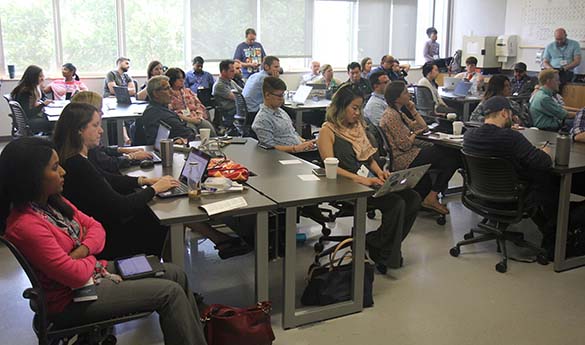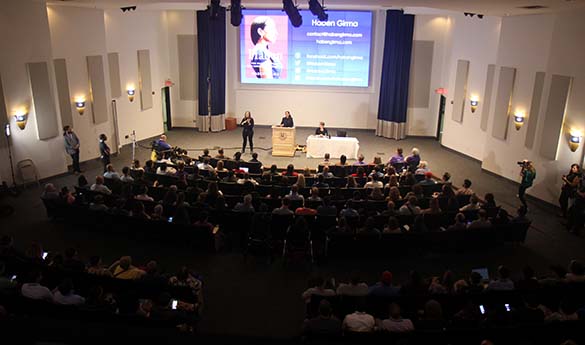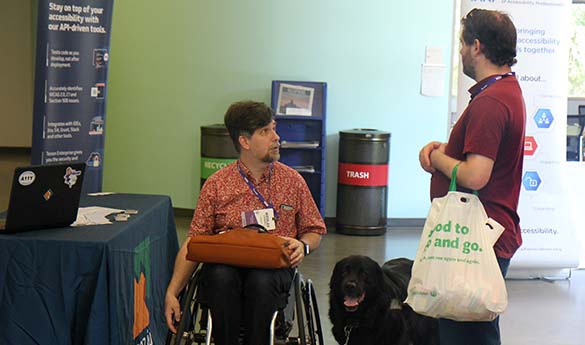May. 21, 2019
After 14 years of hosting Knowbility’s John Slatin AccessU conference, we can say we’re still happy to do it — and we’re still learning.
AccessU provides three days of hands-on, all-encompassing training by digital accessibility experts from all industries, organizations and roles. For those who aren’t familiar, web and digital accessibility are broad terms for the practice of designing and developing online experiences — like websites — so they’re usable for people with disabilities.
As far as we’re concerned, the mission of Knowbility and AccessU dovetails perfectly with the university’s social justice mission.
This year’s AccessU conference brought more than 450 attendees to campus from May 15-17 and included a celebration of Global Accessibility Awareness Day, as well as a keynote from Haben Girma, the first deaf-blind graduate of Harvard Law School. Forever learners, OIT staff were in attendance, and we’ve compiled our biggest takeaways for you.



It's the Little Things
This was my first time attending AccessU. My biggest takeaway and eye-opener was simply how many little things make a big difference in the lives of people with disabilities. As a designer, it’s easy create a webpage through the lens of how I visually see it in front of me — without thinking about how someone who can’t see my work may interact with it. The experience reminded me of the importance of researching and following protocols and best practices while designing.
—David Cuevas, Instructional Designer
Consider the Butter Knife
(Importance of Semantics, Gerard Cohen)
If you ask for a screwdriver and someone hands you a butter knife, you’re going to be confused for a minute — even if you can make the butter knife do the work of the screwdriver. The same principle is true of elements and code on a webpage. Users expect certain behavior from things like clickable buttons. If you’ve used a button in the same way you use a link, you’re going to confuse the user. That’s bad accessibility, but also bad usability.
—Nicole Hill, Client Engagement & Content Strategist
Accessibility Is Good Design
(Efficient & Effective Design: Conserving Cognitive Energy, Glenda Sims)
Whereas most efforts of the web accessibility community tend to focus on designing for physical disabilities, W3C Web Accessibility Initiative’s Cognitive and Learning Disability Task Force is working to improve web accessibility for people with learning and cognitive disabilities. What I appreciated about this session is its focus on how designing for cognitive disabilities also aligns with Universal Design principles, and on how making content more accessible benefits more than just those with physical or learning disabilities.
A big part of of the task force’s work is developing best practices, resources and guidelines for web designers and developers on how to ease cognitive load for site visitors across the spectrum of cognitive disabilities. Have you ever been tired? Hungry? Had a headache? These factors can cause low energy and strain your cognitive load (the workload on your working memory), even if only temporarily. By designing websites with a range of cognitive disabilities in mind, you can keep users engaged with your content and your site.
—Jenny Cha, Instructional Designer
It's Not All About Websites
(Accessible PowerPoint Presentations, Michael Zapata)
PowerPoints can be accessible, too! There are some simple tips for making your PowerPoint accessible:
- Choose a solid or simple background
- Add a title to every slide
- Add alternative text to images by editing the image description
- Use sans-serif fonts
- Avoid italics or all-caps
—Brenda Adrian, Associate Director, Instructional Technology
The Work of Accessibility Is Never Finished
(Accessibility Testing, the Deep Dive, Mike Moore)
Even in 2019, accessibility problems remain with us on the web, but technical standards and best practices are evolving, which means overall accessibility is improving. For example, writing HTML using built-in semantic markup (e.g., <button> for a button or <main> for the main section of a page) goes a long way toward leveraging the in-browser accessibility tools that exist already. Other examples include factoring in screen-reader behavior and considering which elements get the focus — and in what order — when a user tabs through a page.
Knowing how to find and diagnose accessibility issues requires both automated and manual user testing. It’s important work, but it can seem overwhelming. So, it’s helpful to remember that web accessibility issues come in different shapes, sizes and, importantly, severities, which can help you prioritize and start tackling problems.
—Nate Foxley, Web Developer